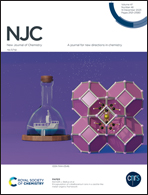Efficient solution-processable deep-red hot exciton emitters based on thiadiazole[3,4-c]pyridine for a simple electroluminescent device†
Abstract
Here, we report the synthesis and characterization of a solution-processable deep-red hot exciton fluorophore (CTTPy) based on a donor–π–acceptor–π–donor (D–π–A–π–D) type structure and its application as a non-doped emitter in an organic light-emitting diode (OLED). CTTPy contains electron-deficient thiadiazole[3,4-c]pyridine (TPy) as a strong acceptor, 3-hexylthiophene as a π-linker, and a carbazole dendron as a donor. The solvatochromic studies and theoretical calculations support that CTTPy is a hot exciton emitter with hybridization of both locally excited (LE) and charge transfer (CT) features of emission. Thanks to the strong electron deficiency of the TPy central core, bulkiness, and electron-donating and hole-transporting properties of end-capped carbazole dendrons, CTTPy displays a strong deep red emission (λem = 681 nm) with a decent fluorescence quantum yield of 54%, thermally stable amorphous morphology (Tg = 214 °C), good thin film forming ability by solution casting, and appropriate energy levels. CTTPy is effectively applied as a non-doped emitter in a solution-processed OLED which emits deep red electroluminescence peaked at 674 nm with CIE coordinates of (0.667, 0.327), an EQEmax of 3.66% and a considerably high exciton utilization efficiency (EUE) of 59%. This work not only provides a new strategic design for the construction of deep-red pure organic fluorescent materials, but also further ratifies that the ‘‘hot exciton’’ mechanism can also be successful in solution-processed OLEDs.
![Graphical abstract: Efficient solution-processable deep-red hot exciton emitters based on thiadiazole[3,4-c]pyridine for a simple electroluminescent device](/en/Image/Get?imageInfo.ImageType=GA&imageInfo.ImageIdentifier.ManuscriptID=D3NJ04281B&imageInfo.ImageIdentifier.Year=2023)


 Please wait while we load your content...
Please wait while we load your content...